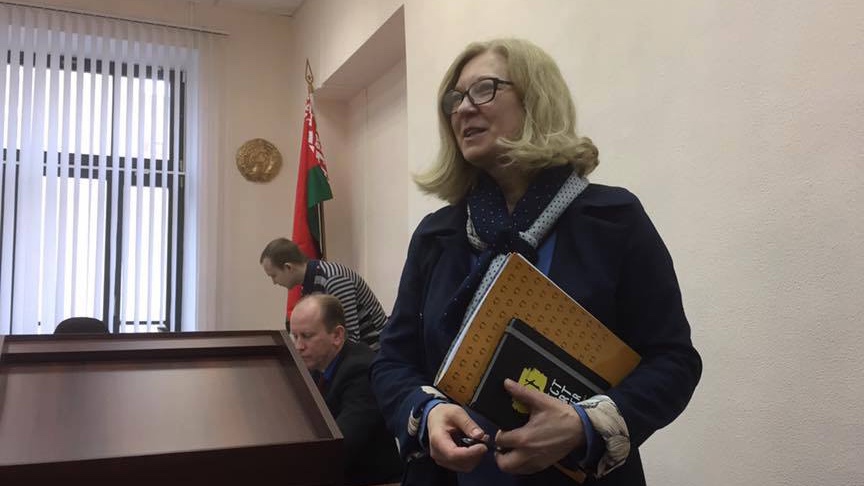On 26 March 2017, Tatsiana Reviaka was arrested while monitoring protests. Speaking at the hearing, she said that the proceedings against her “served the purpose of discrediting her as a human rights defender.”
“Such arrests, charges, and fines are mechanisms that the Belarusian authorities use to create fear and deter people from expressing views or organising in a way that the Government deems undesirable. Such fear is created by a system in which at any given time, anybody can be arrested, detained, and sentenced for exercising their rights to association, assembly, or expression, or for being a human rights defender, said Maria Dahle, Executive Director of Human Rights House Foundation (HRHF).
“The Belarusian authorities must stop punishing human rights defenders in an effort to deter them from their legitimate work, and put an end to these systematic and systemic punitive mechanisms,” she added.
At the hearing, attended by a trial observer for HRHF and the Belarusian Human Rights House, Tatsiana Reviaka said that the specific charges against her are meant to illustrate that the authorities find nothing wrong with the demonstrations, and that it is only the people participating in them that are bad.
In recent judgements against peaceful protestors, the Belarusian Courts have reportedly avoided mentioning the demonstrations, seeking to portray demonstrators and observers simply as hooligans on the streets.
“In Tatsiana Reviaka’s case, refusing to mention the demonstration can be seen as an attempt to refute her monitoring role as a human rights defender, and the international standards and protections she is entitled to in this role. It could also be a sign that the authorities, by denying that they arrest demonstrators and observers during protests, are seeking to downplay the demonstrations and hide their attacks on the right to assembly from the international community,” commented Maria Dahle.
Tatsiana Reviaka recalled the details of her arrest. That day she went to monitor a peaceful protest action held at October Square. She was standing with journalists near the prisoner transport vehicle. She was arrested and transferred to the central police station.
Following an enquiry by the judge, she stated that she saw the police officers who allegedly arrested her for first time in the courtroom.
The trial observer reported that the statements given by the two police officers in the courtroom were almost identical, but then sometimes contradicted each other. The police officers said that people at the protest action were cursing, violating public order and disobeying police orders, and that Tatsiana Reviaka herself did not obey the demands of the police: she sat down on the ground and was pulling law enforcement officials by their uniforms.
Her defense submitted a video and photo files to the court, which contradicted the statements and reports of the police. One of the eyewitnesses to the arrest also rebutted the claims of the two police officers. At Tatsiana Reviaka’s request, the text of a letter from the Human Rights House Foundation to the court was read out in its entirety.
Tatsiana Reviaka recalled that during the arrest, the people that conducted it did not identify themselves as law enforcement officers and did not read them their rights. After taking them (around 15-20 people) to the police station, they were held in the yard for three hours and were made to stand in line. If anyone dared to turn their heads around or move their hands, they were beaten with police batons and were subjected to inhuman and degrading treatment. They also reportedly took her phone and deleted certain photos and videos. After a three-hour wait she was given papers to sign and then allowed to leave. She was not given any notice/information about ongoing administrative proceedings against her and only found out about them after receiving the summons by the Court.
Tatsiana Reviaka has filed a complaint for the violations that occurred during and after her arrest.
—
Monthly newsletter of the Human Rights Houses and HRHF
This article was first published as part of the monthly newsletter of the Human Rights Houses and HRHF. Sign up to receive news and insight into human rights issues and country situations, the projects and activities of Human Rights Houses, and portraits and interviews with human rights defenders.
Documents:
- Briefing note on Belarus April 2017: A system that allows human rights violations at any given time
This April 2017 briefing note on Belarus was prepared by Human Rights House Foundation with the support of the Barys Zvozskau Belarusian Human Rights House. - Letter of Concern from HRHF on Tatsiana Reviaka’s trial
The Human Rights House Foundation (HRHF) submitted information to the Court on the case against Tatsiana Reviaka in April 2017.
More on recent arrests and attacks on peaceful protestors in Belarus
Belarus Court sets new date for trial of human rights defender
True face of Belarus: Systematic repression
Belarus: Prominent human rights defender detained as protests continue
Civic Solidarity movement condemns detentions and violence against protestors
Belarus detains dozens amid “social parasite” protests
The Barys Zvozskau Belarusian Human Rights House
The Belarusian Human Rights House (HRH) addresses the main challenges faced by human rights activists in Belarus – the right to assembly and freedom of expression. This is achieved through the provision of a safe training and meeting space and facilities for human rights defenders, NGOs, journalists, students and teachers, as well as for international meetings and cultural events. Read about and news from the organisations:





